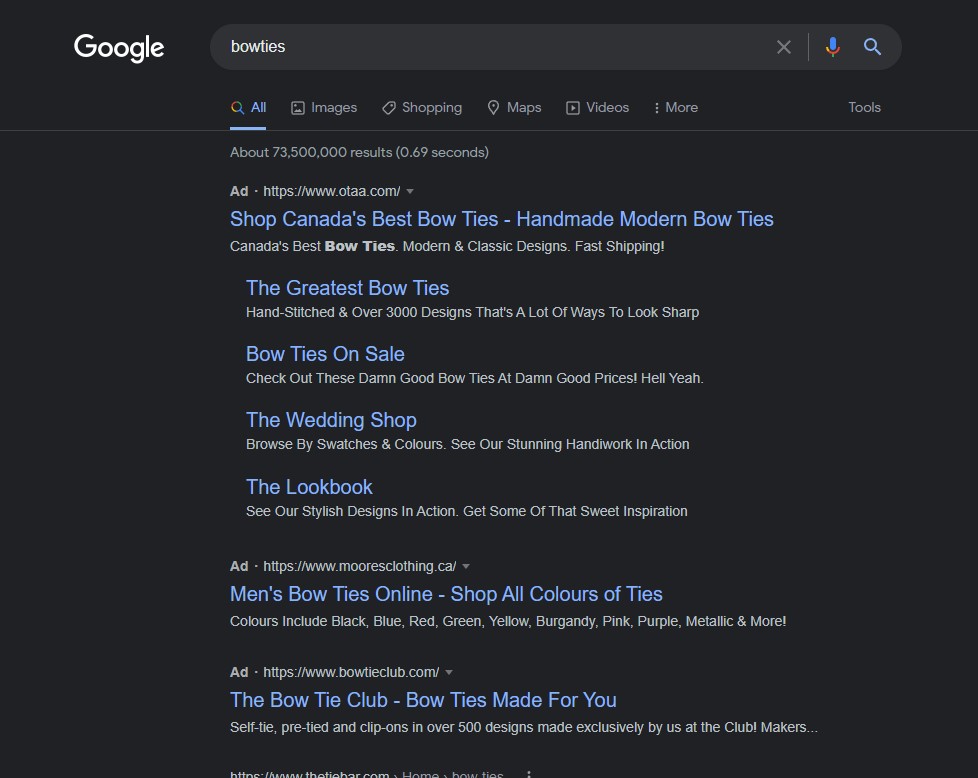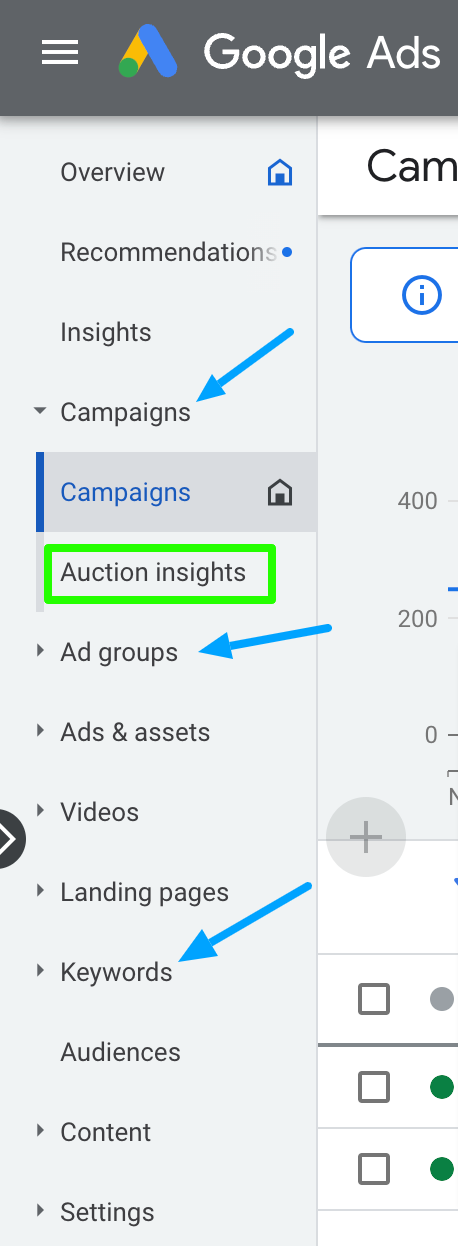Ever participated in an auction? Placed a bid on something? All that auctioneer-speak isn’t just reserved for storage units and pawn shops. Advertising on Google works much the same way with Google Ads Auction.
It works like this: You place your bid, which is the maximum amount of money that you’re willing to pay for a click on your ad, and the algorithm (essentially) does the rest.
How can you know what you’re doing right and in what areas to improve? The answer is the Google Ads Auction Insights Report. The pre-built report is a feature that’s baked into Google Ads that, in their own words, “Provides information on other advertisers who’re also bidding on the same keywords as you”.
The information and data presented in this report are incredibly valuable for advertisers. When used strategically, the Google Ads Auction Insights Report can help you make informed decisions on your Ads approach. It tells you what’s working and where, as well as how to improve on certain things that perhaps are not proving as effective as you had hoped.
Here is everything you need to know about the insights report, including how it works, where you can access it and some of its standout features/information. We have the insight on the insights!
An Introduction to Auction Insights in Google Ads
Without getting too jargony, Google separates its auction insights by category. Depending on which column your ads fall into, users will have access to choice statistics that may or may not be available across the sections. We’ll break some of the most common categories down right here.
And don’t worry — if terms like “impression share” don’t mean much to you right now, we’ll also be breaking those down a bit later, explaining what they mean with a bit more depth, so stay tuned!
Search Campaign
Search campaigns are those text-based ads that appear at the top of Google’s search engine results page (SERP). They look like this:

The insights report for this type of campaign will highlight 6 statistics, including:
- Impression share (IS).
- Overlap rate.
- Outranking share.
- Position above rate.
- Top of page rate.
- Absolute top of the page rate.
Shopping Campaign
Shopping campaigns also show up at the top of the SERP but provide a bit more information about a product, including a picture. They look like this:

Auction insights metrics available for these types of campaigns are limited to 3, including:
- Impression share.
- Overlap rate.
- Outranking share.
Performance Max Campaign
Performance Max campaigns help advertisers drive performance across all of Google’s advertising channels, such as YouTube, Display, Search, Discover, Gmail and Maps.
The report for Performance Max campaigns includes auction insights segmented by Search and Shopping ads, and is available at the account and campaign level.
More in-depth information, directly from the source, can be found here.
How Google Ad Auction Works
An auction happens every single time a user searches something on Google. Effectively, this process will determine when, where and which eligible ads — if any at all — will appear on the SERP.
In short, here’s how that process unfolds:
- When someone searches, the Google Ads system finds all ads whose keywords match that search.
- From those ads, the system ignores any that aren’t eligible, like ads that target a different country or are disapproved based on a policy violation.
- Of the remaining ads, only those with a sufficiently high Ad Rank may show. Ad Rank is a combination of your bid, ad quality, the Ad Rank thresholds, the context of the person’s search and the expected impact of extensions and other ad formats.
The 5 Main Factors That Determine Which Ads Will Appear
It’s no surprise that advertising on Google is an algorithmic game — save for a few exceptions, like paid ads. But, even these fall under the influence of Google’s (maybe, probably justified) manipulation to some extent, too.
The fate of your ad and whether or not Google decides to show it is largely determined by these 5 factors:
- Your bid: How much are you willing to pay for a click on your ad? This number will play a factor in determining how likely Google is to push it to the front (or top). In most cases, the amount that an advertiser will end up paying compared to their initial bid is far less, according to Google.
- The quality of your ads: How relevant or useful are your ads? Further, Google will also look at the website behind your ad — aka the one the ad links to — to make this determination. An assessment is done and your ad is given what Google calls a Quality Score, which you can work to improve if it’s not quite where you’d like it to be.
- The expected impact from your ad extensions and other ad formats: Ad extensions are things such as a phone number or additional links to other pages that are included in your ad. Google will make determinations about your ad based on how it thinks your extensions will impact it. According to Google, it’s entirely possible to “Win a higher position [over your competitor] at a lower price by using highly relevant keywords, ads and extensions”.
- Your Ad Rank: Google has a minimum threshold for ad quality. To be eligible to show in certain positions, your ads must at least meet the minimum expectations.
- The context of your ad: Context is important. Google says, “When calculating Ad Rank, we look at the search terms the person has entered, the person’s location at the time of the search, the type of device they’re using, the time of the search, the nature of the search terms, other ads and search results that show on the page, and other user signals and attributes.”
Together, these 5 variables will determine when (and if) your ad will appear to potential customers. But it’s not all up to chance! There are ways to optimize for choice ad spots. Read on to find out how.
Firstly, how do you even access the report?
Subscribe to
The Content Marketer
Get weekly insights, advice and opinions about all things digital marketing.
Thank you for subscribing to The Content Marketer!
How to Access the Auction Insights Report
So, where exactly do you find the auction insights report? Google has a short 7-step process for how to find and access it:

- Sign in to your Google Ads account.
- Click the Campaigns, Ad groups, or Keywords page menu based on what information you want to be displayed in the report.
- Select a specific campaign, ad group, or keyword by checking the box next to each item. Note: You can only select keywords on a single page at a time (unless you run a report for “All”).
- Click Auction insights.
- You’ll now be taken to your auction insights report. Note: Only keywords and ad groups that meet a minimum threshold of activity will have the auction insights report.
- If you selected only Search or only Shopping campaigns or ad groups, you’ll find the corresponding auction insights report.
- If you selected a mix of Search and Shopping campaigns or ad groups, you’ll need to select the Search campaigns or Shopping campaigns radio button.
A Brief Breakdown of Google Ads Auction Insights Statistics
Now that we know what kind of statistics are available in these auction insights reports, we need to know what they are — which will help us understand why they’re important.
Impression Share
Impression share is a percentage generated by comparing the actual number of impressions that your ads receive against the potential number of impressions that they could be getting.
To put it simply, if your ads received 1,000 impressions (hallelujah), but 10,000 impressions were possible, your impression share would be 10%.
Overlap Rate
The overlap rate metric is a number that represents how often a competitor’s ad receives an impression when your ad also receives an impression.
Say your overlap rate column is showing 30%. This means that, 3 out of every 10 times that your ad showed, an ad from a particular competitor showed as well.
Outranking Share
The higher your outranking share, the better! You probably guessed it — this one is representative of how often your ad ranked higher than someone else’s; Or, even if yours ranked and theirs did not.
Position Above Rate (Search Campaigns Only)
Google has done a great job of summarizing what these statistics represent. The position above rate will tell you how often a competitor’s ad was shown in a higher position than yours — but only when the two ads appear at the same time. Think: How often was that competitor’s ad in a position above mine? This stat will tell you!
Top of Page Rate (Search Campaigns Only)
Top of page rate tells you how often your ad was shown at the top of the page — above the unpaid search results.
Absolute Top of Page Rate (Search Campaigns Only)
And lastly we have the absolute top of page rate. Similarly to the top of page rate, this stat tells you how often your ad was shown at the absolute top of the page as the very first ad in the lineup.
How Impression Share is Calculated
If you haven’t brushed up on your math skills recently, don’t worry — we haven’t either. But, impression share — and all of the aforementioned statistics that Google includes in their various auction insights reports — are essentially equations.
We’ve decided to take a bit of a deeper dive into impression share because, overall, it provides the quickest, most succinct way of communicating how your ads are doing. We’ll also touch on absolute top impression share, often abbreviated to ATIS.
Looking to optimize Google ads in full? click there for the scoop.
IS
Impression share = impressions / total eligible impressions
ATIS
Absolute top impression share = absolute top impressions / total eligible top impressions
How to Improve Your Impression Share
If you need a crash course on improving your impression share, you’re not alone. Since a lot of these processes rely on data and algorithms, there are pretty reliable ways to optimize — including increasing your ad spend. Here are a handful of best practices, straight from Google, about how to better your impression share.
- Increase your campaign budget.
- Increase your bid.
- Decrease regional targets.
- Re-adjust your budget.
- Improve your ad quality.
While these methods are not guaranteed to increase your impression share with Google Ads, they are excellent tips to keep in mind.





